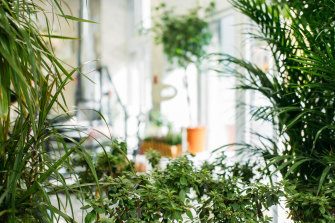Most of us feel good in nature, so it’s no surprise that spending more time indoors tends to have the reverse effect.
Research shows that a disconnect with the natural world can be detrimental to our physical, mental and emotional health, so what can we do to remedy this when getting outside isn’t an option? Recognising our affinity with nature, a concept known as biophilia, and designing our homes accordingly, is a great place to start.

Bringing nature indoors is linked to a vast amount of health benefits.Credit:
“Biophilia is a scientific term, the best way to explain it is by thinking about how you feel when you go to the beach or for a bush walk, perhaps a picnic in the park,” explains Suzie Barnett, general manager of Sydney-based ‘living infrastructure’ company Junglefy, and Chair of the Biophilic Design Initiative. “You probably feel lighter, calmer and happy.” This makes sense, says Barnett, because we’ve evolved in nature so we’re hard-wired to be connected to it.
By extension, biophilic design involves bringing nature into our built environment and communities. “The benefits of biophilic design have been linked to an extraordinary number of positive health improvements, physically, psychologically and socially both short and long-term,” says Barnett, adding that creating a biophilic home doesn’t need to be expensive or complex. “In my opinion it is not a nice-to-have or the latest design trend, it is in fact something so functional and essential to our wellbeing that we can’t afford not to include it into our homes.”
The power of plants
While you might already own a pot plant or two, the real benefits come from taking a “more is more” approach to indoor greenery.
“One of the easiest and most basic ways to introduce biophilic design into our homes is by introducing plants and lots of them,” says Barnett.
The real benefits come from taking a “more is more” approach to indoor greenery.
Short on floorspace? Plants can be hanging, wall-mounted, or displayed as a table centrepiece. Fresh, clean air goes hand-in-hand with a healthy home, so introduce varieties proven to enhance air quality – according to a NASA study, aloe, spider plant, chrysanthemum, bamboo palm and peace lily are among the best at removing toxins and pollutants from the air.






